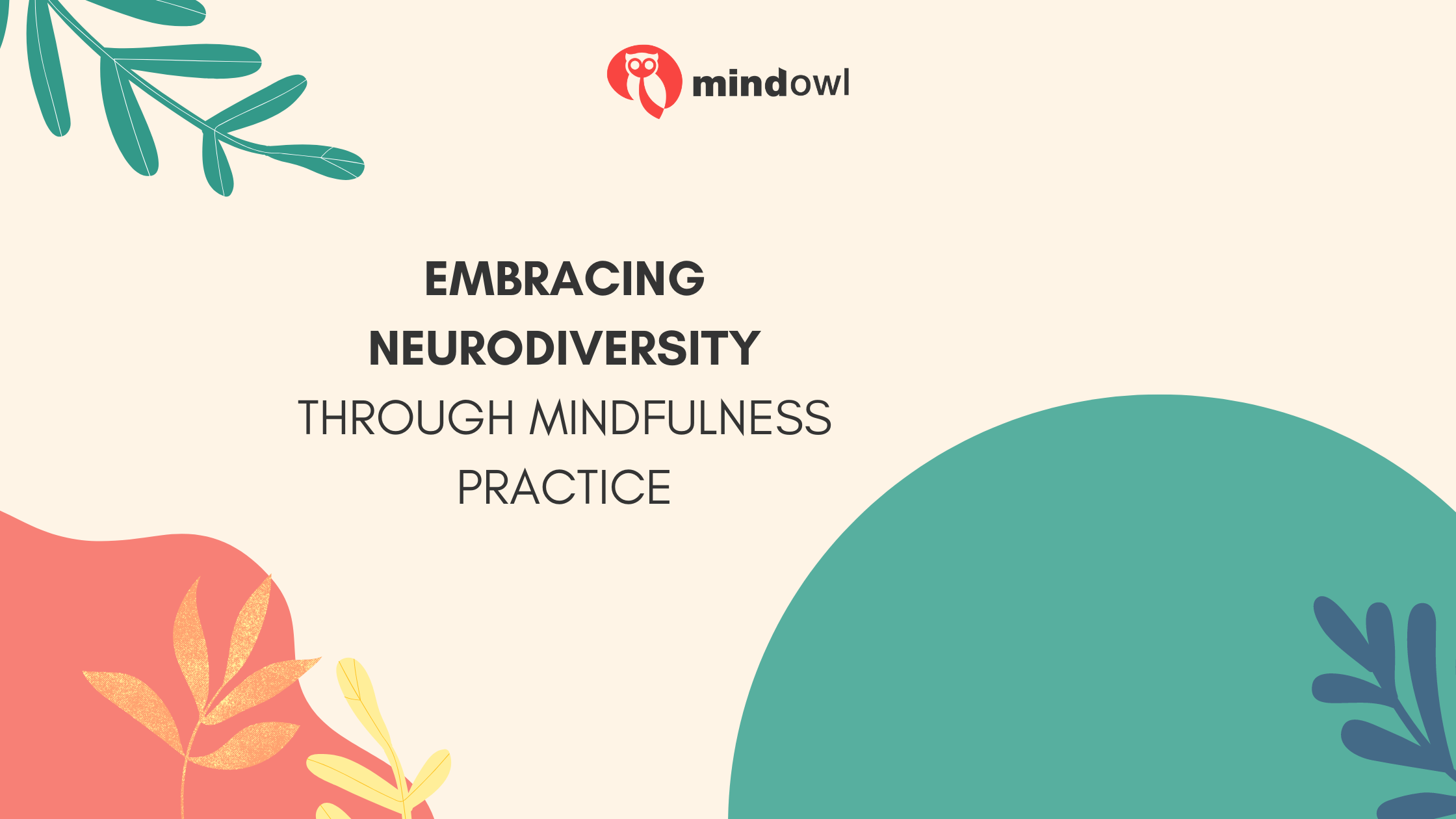Sometimes, people feel left out because standard ways of being mindful don’t fit their needs. This is especially true for folks whose brains work a bit differently—like those who are neurodiverse.
Did you know? Inclusive teaching can open the doors of mindfulness to these diverse communities.
Our guide will walk you through how we can adjust mindfulness practices to support and celebrate neurodiversity—from understanding what makes each brain unique, to offering tips that make being present in the moment more accessible.
Whether it’s using movement, grounding techniques, or breathwork, there’s a way into mindfulness for everyone. Stick around to find out how!
Key Takeaways
- Mindfulness can be adapted to meet the unique needs of neurodiverse individuals, such as those with ADHD and autism.
- Neurodiversity is celebrated through tailored mindfulness practices that recognise each person’s different way of sensing and interacting with the world.
- Practices like moving meditation or focusing on physical sensations help make mindfulness accessible and enjoyable for everyone, supporting their mental health and well-being.
- Grounding techniques and breathwork offer simple ways to stay present and reduce anxiety without needing special tools or settings.
- Embracing diverse perspectives in mindfulness practice promotes an inclusive environment where all community members feel valued.

Exploring Neurodiversity
Neurodiversity covers the wide range of ways our brains work and perceive the world. It includes people with ADHD, autism, and other neurodevelopmental differences. These individuals often experience life in unique ways due to how their brains process information.
This concept moves us away from seeing these differences as deficits. Instead, it celebrates them as variations in human cognition and sensory perception.
Celebrating the diversity of brain function and behavioural traits represents a shift away from pathologising some as normal and others as abnormal.
Making mindfulness accessible for these diverse communities involves understanding their specific needs. Traditional mindfulness practices might not always fit everyone’s needs because we don’t all sense or interact with the world in the same manner.
Mindfulness Challenges for Neurodivergent Individuals
Mindfulness exercises, like focusing on your breath or sitting still, can be tough for neurodivergent people. Their brains work differently, making things that seem simple to others quite complex for them.
For instance, someone with ADHD might find it hard to stay still and concentrate on their breathing. Meanwhile, a person with autism could feel overwhelmed by sensations during a body scan exercise.
These activities aim to calm the mind but can end up doing the opposite for some.
Offering directions that are clear and easy to follow helps a lot. Yet, even with guidance, practising mindfulness in traditional ways doesn’t always work out. That’s why adapting these practices is crucial – using movement or focusing on something specific outside oneself can make a big difference.
This shows us there isn’t just one way to meditate or be mindful. Everyone needs tools that suit how they think and feel best.

Insights from the Autism Spectrum
People on the autism spectrum bring unique views to mindfulness practices. They add a special perspective that can change traditional ways of teaching and practising meditation. The growth of self-advocacy in the autistic community has sparked new discussions about how we approach mindfulness and meditation.
This includes looking at what works best for autistic adults and children, focusing more on their strengths.
Understanding these perspectives helps teachers create more accessible mindfulness exercises. Techniques like guided practices or incorporating physical sensations help cater to varied needs.
Sue Hutton from the CAMH Azrieli Adult Neurodevelopmental Centre, along with Yona Lunsky’s research, show us there’s no one-size-fits-all method in teaching mindfulness to people with neurodevelopmental disabilities.
Tailoring Mindfulness for Neurodivergent Needs
Tailoring mindfulness for neurodivergent needs involves adapting practices to suit diverse sensory experiences and cognitive styles. This includes incorporating movement, employing grounding techniques, and practising breathwork to cater to varied needs within the neurodiverse community.
Incorporate Movement
Mindful movement lets individuals positively use their physical energy while they are practising mindfulness. It offers a unique path to managing emotions, understanding social cues, and navigating day-to-day interactions more smoothly.
Including activities like walking meditations or simple stretching exercises can make a big difference. These practices allow people to focus on the moment through the sensations of their moving bodies.
For some, it’s easier to achieve calmness and clarity this way than sitting still. Making these adjustments opens doors to new forms of self-expression and ways to connect with others—and that’s something truly powerful.
Employ Grounding Techniques
Grounding techniques bring people back to the here and now, which is great for folks who feel overwhelmed. Imagine putting your feet firmly on the ground and feeling more secure right away.
These methods help reduce worry by focusing on present feelings rather than stressful thoughts. Think about using simple things like touching a piece of fabric or holding a cool stone.
Breathing slowly while noticing different sensations around you works wonders too. You might listen to soft rain sounds or smell fresh grass. This kind of attention helps with staying calm in moments that could otherwise feel too intense.
Grounding doesn’t need fancy tools; it’s all about using what you have in your surroundings to find peace in the moment.
Practice Breathwork
Breathwork is a key part of mindfulness for those who are neurodiverse. It helps calm the mind and reduce stress. The 4-7-8 breathing technique is great for moving from feeling busy to feeling more relaxed.
This method involves inhaling deeply for 4 seconds, holding that breath for 7 seconds, and then exhaling slowly over 8 seconds. Doing this can make a big difference during meditation or any stressful time.
Breathing in deeply calms the body and mind, making it easier to focus.
Mindfulness teachers often suggest using guided imagery along with breath exercises to enhance relaxation. Imagine being in a peaceful place while focusing on slow, steady breaths – this combo works wonders for reducing anxiety and sensory overload found often among individuals within the autism community.
Every session taps into new ways of thinking, promoting an inclusive mindset towards various methods of practicing mindfulness meditation specifically tailored to meet diverse needs.
Mindfulness Benefits for Neurodivergent Individuals
Mindfulness makes neurodiverse individuals feel calmer and less anxious. Practices, like meditation and grounding techniques, also improve focus.
This means they can handle stress better and sleep well at night. For people with autism or ADHD, these benefits make daily life much easier.
Through guided meditations and breathing exercises, mindfulness teaches self-awareness without judgment. Neurodiverse individuals learn to understand their feelings and thoughts better. This helps them in social situations where they might feel overwhelmed before.
Conclusion
Embracing neurodiversity through mindfulness practice fosters inclusivity and self-acceptance. Tailoring mindfulness techniques for neurodivergent needs is crucial, incorporating movement, grounding techniques, and breathwork.
Recognising and celebrating the unique contributions of neurodiversity fosters a culture of inclusivity that benefits all members of our community. The neurodiverse perspective enhances the richness of our collective experience while promoting understanding and acceptance.
Tailoring mindfulness to accommodate different needs unlocks its potential to support individuals with various neurological differences on their journey towards increased well-being.
FAQs
1. Why is it important to practise mindfulness for neurodiverse individuals?
Practising mindfulness helps neurodiverse people manage stress and navigate their sensations more comfortably.
2. Can everyone use the same meditation practices effectively?
Since we don’t all meditate in the same way, inclusive teaching practices are crucial. For example, telling someone who finds it hard to “close your eyes” and imagine might not work well.
3. What’s special about mindfulness practices for neurodiverse meditators?
These practices bring a fresh perspective to traditional mindfulness techniques. They focus on recognising every individual’s unique experience with meditation.
4. How does mindfulness support caregivers in the disability community?
Mindfulness offers caregivers tools to reduce stress and increase patience and empathy—essential qualities when supporting someone with a neurodevelopmental disability.
5. Is there a connection between mindfulness and education for neurodiverse individuals?
Mindfulness in education settings opens up pathways for better learning experiences by helping students tune into interoception—their inner sense of bodily feelings—and improve attention skills without feeling overwhelmed.
6. What makes embracing neurodiversity through mindfulness so important today?
It’s vital because it moves us away from pathologising differences towards celebrating diversity in all forms—creating an inclusive world where everyone has something valuable to offer.
MindOwl Founder – My own struggles in life have led me to this path of understanding the human condition. I graduated with a bachelor’s degree in philosophy before completing a master’s degree in psychology at Regent’s University London. I then completed a postgraduate diploma in philosophical counselling before being trained in ACT (Acceptance and commitment therapy).
I’ve spent the last eight years studying the encounter of meditative practices with modern psychology.


